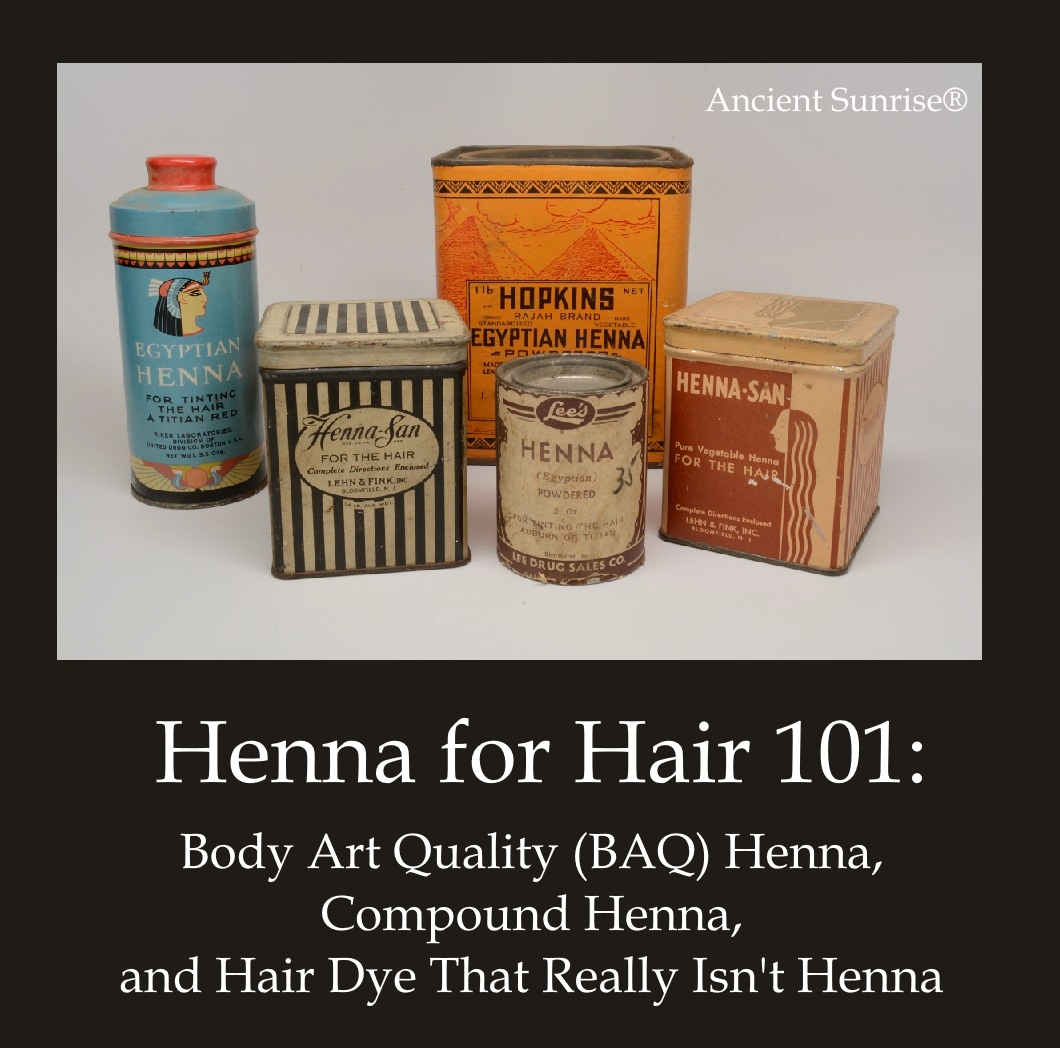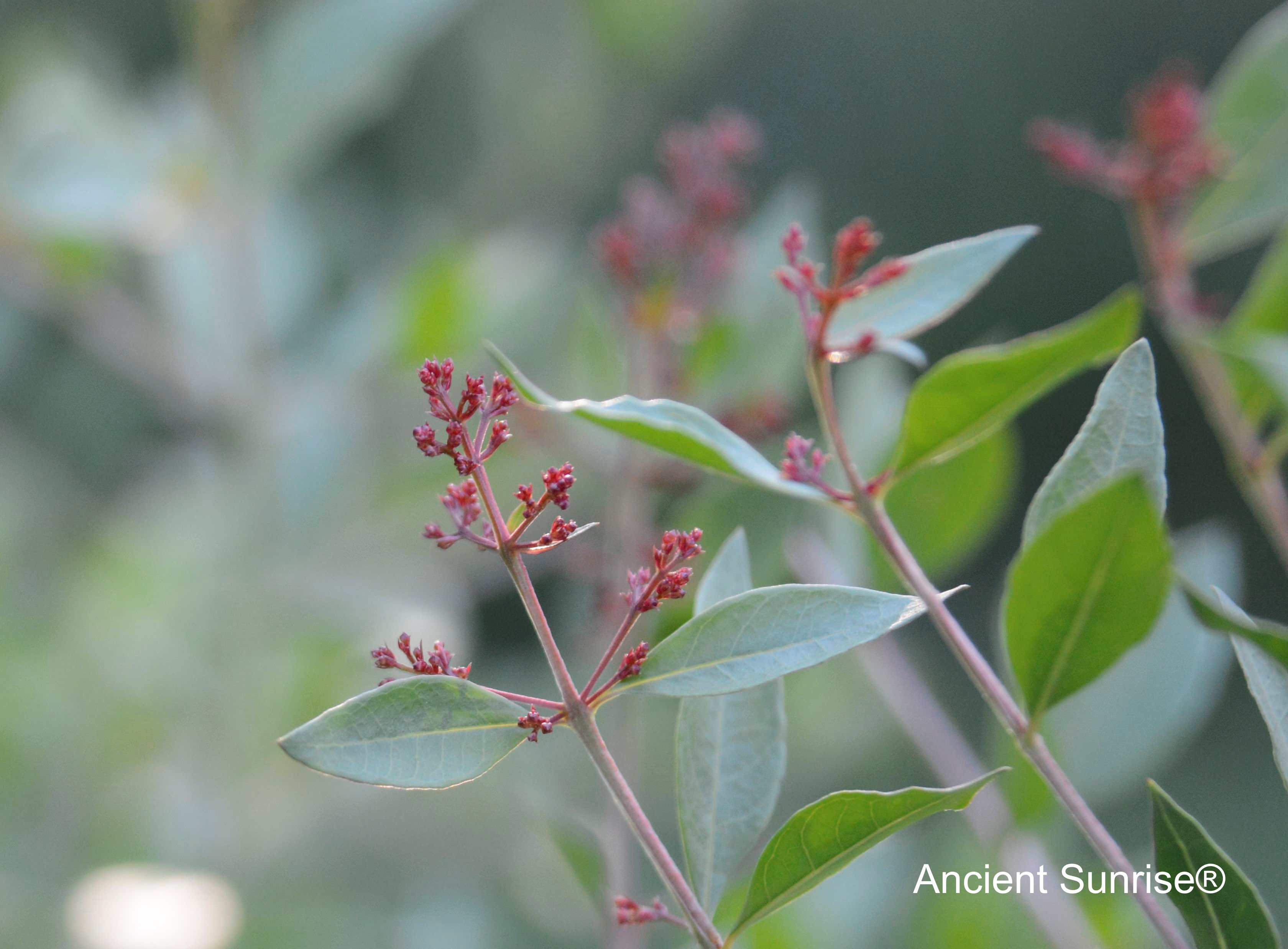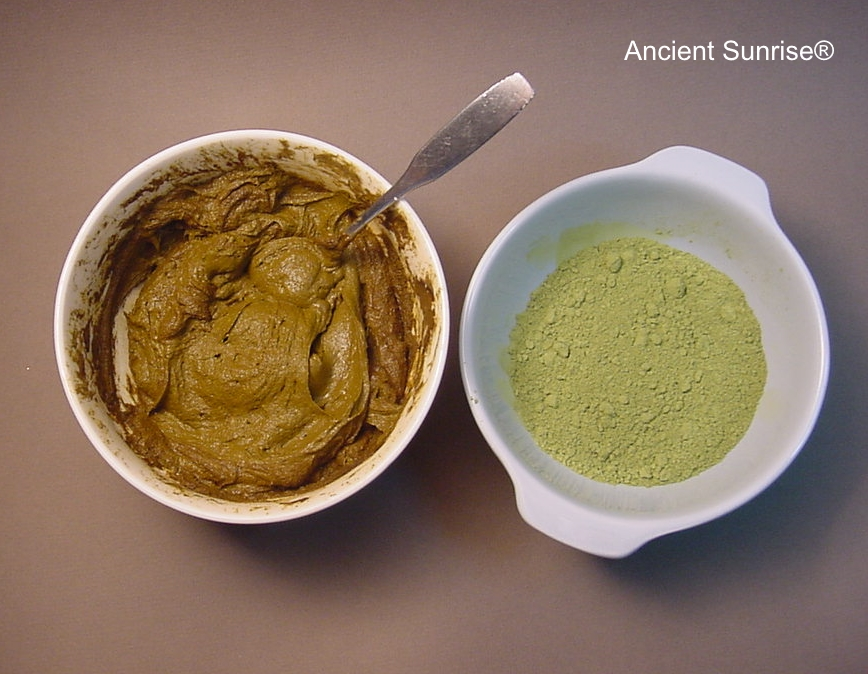Defining the Word “Henna”
To those who are new to using henna as hair dye, the word “henna” itself may be confusing as well as the terms “BAQ” and “compound henna”. Health stores and internet suppliers carry an array of hair dye products labeled as “henna,” which may be either in powder, cream, liquid, or solid form. They might offer color results from blonde to jet black, and call it “blonde henna,” “light brown henna,” and so forth. To add to the confusion, one might be familiar with images of body art using traditional henna, “black henna,” (Run away. Fast.) “white henna,” and even metallic henna temporary tattoos.
It is therefore important to establish what “henna” actually is. While it is all too commonly used in these ways, it is not a word to catch all natural (or claiming to be natural) hair dyes, and it is not a body art style. Henna is one specific plant, lawsonia inermis, which produces a natural dye called lawsone. This dye binds to keratin, staining it an orange-red color. The processed product of lawsonia inermis is a powder that can be mixed into a paste, and used as a dye.
Henna, lawsonia inermis, is a plant whose leaves contain a red-orange dye called lawsone.
What Can Be Called Henna Hair Dye?
Sadly, the answer is almost anything. Because the words “henna” and “natural” are not regulated, any company can produce a hair dye that contains little to no lawsonia inermis plant powder and still put those words on the label.
Henna only produces stains in a range of orange to deep red. Any powder product that dyes hair a color other than red will contain other ingredients. These may be other plant powders, such as indigo and cassia. They may also be dyes or metallic salts. Many companies pre-mix these powders, and add additional ingredients, either plant-based or man-made. Premixed powdered hair dyes are called Compound Hennas.
“Henna” hair dyes, in powder, liquid, or solid form, can be called henna even if the closest ingredient to lawsonia inermis listed is “henna extract.” In other cases, henna or lawsonia inermis will be listed as a main ingredient, but a consumer needs to keep in mind that distributors are not always required to disclose their full list of ingredients, depending on the country of origin. It is important to keep in mind that there may be much more than henna and plant powders contained in the product.
This “henna natural conditioner” claims to condition the hair without changing color. Henna is the last ingredient listed.
Compound Henna
Henna has been used for centuries in the hot, semi-arid areas where it naturally grows. As westerners learned of henna and its benefits, its popularity spread and the market grew. Distributors mixed plant powders with metallic salts in an attempt to cheapen the product and simplify its use. Traditionally, henna must be mixed with a mildly acidic liquid, left for several hours to dye release, applied, and left for several hours in the hair. Additives allowed henna to be mixed and used right away, and rinsed after a shorter period of time.
These additives could also allow for a wide range of colors and make up for poor-quality henna. Compound hennas claiming to dye hair dark brunette or black may contain para-phenylenediamine (PPD), the same toxic chemical used in commercial dyes, and used in high concentrations as “black henna” body art.
An old advertisement for compound henna in 14 shades, including “white.”
Compound henna has given true henna a bad reputation. Most hair stylists have been taught that henna will damage hair, and that hennaed hair can never be dyed with conventional dyes again. Yes, the chemicals in salon hair dyes can react with metallic salts to horrific results (Your hair may burn and melt, literally) but there is no problem using conventional dyes before or after pure henna. Pure, BAQ henna improves hair rather than damages it. This is one of several reasons it is crucial to push for education on the differences between pure henna and compound henna, and to call for more regulation on products claiming to be henna.
Liquid Henna
“Henna” hair dye might also be offered in a liquid or cream form. These are far from natural. Henna, when mixed into a paste, has a shelf-life of 48 hours before the dye demises. If a liquid product containing henna is sold at room temperature, it no doubt contains a myriad of additives to preserve the henna dye, or it contains little to no henna. In some cases, a scan of the ingredients list will show that the closest thing to henna is “henna extract,” somewhere down near the bottom of the list. An unsuspecting customer may believe they are buying henna for hair, when in reality they are buying a product that is more similar to a conventional boxed dye, but which contains some small amount of a henna plant derivative.
At 65 degrees Fahrenheit, henna paste will begin to demise 48 hours after mixing. If a ‘henna’ product is a sold as a cream or liquid on a store shelf, it will contain additives such as preservatives and dyes.
Poorly Sifted Henna
Even when henna is really henna, it varies in quality. Traditionally, “henna for hair” was henna powder of a lower sift, containing bits of leaves, stems, and sand. Because it was not meant for squeezing delicate designs out of a fine-tipped cone, henna sold for use as hair dye did not have to be as finely processed, and was therefore less costly. This gave henna a bad reputation for being difficult to apply and rinse, leaving hair a damaged, tangled mess.
The sale of low quality and adulterated henna is not always done maliciously. Some companies which sell natural plant powders source their products from distributors who also believe their products are pure. Smaller shipments of henna are easy to move quickly, and may vary from batch to batch. These companies trust the word of the henna producers that the products is pure, high quality, and safe, and therefore advertise their products as such.
Having large amounts of high quality, finely sifted henna requires having the facilities to produce consistently and at that scale. Having confidence in purity requires being able to test for the chemical components in each batch, which can be very costly.
Pre-Mixed Henna Products
Some companies sell products containing decent quality plant products and none of the harmful stuff, but they formulate their products in such a way that produces inferior results. This is because they believe that plant powders can be mixed together for easier use. These dyes may be a package of henna, indigo, cassia, and other natural ingredients blended into one powder. The instructions might recommend mixing the powders with hot or boiling water, and applying the mix right away. Some may sell in a solid form, mixing the plant powders with oils and plant butters so that the product can be melted into a paste.
Preparing a henna for hair mixture can be complicated for new henna users, and requires patience. Henna paste must be mixed with a mildly acidic liquid and allowed to dye-release at room temperature for 8-12 hours. This slow dye-release allows for rich, permanent color. Indigo, releases its dye immediately once mixed with water, and will demise quickly afterward. Henna paste must be mixed earlier, and then indigo is mixed and stirred into prepared henna paste just prior to application.
Premixed powders try to compensate for the difference in dye-release times by recommending a hot liquid, which forces henna to dye-release immediately at the same time as the indigo, but with much weaker and lighter results. This is one reason there exists a myth about henna turning hair green. Weak henna, overpowered by indigo’s natural green-blue hue, will lead to undesired results.
With boiling water, henna’s dye will release immediately, but demise quickly and create weak results that fade.
When dye released separately and then combined, henna and indigo’s dyes work together to create beautifully natural shades of brown. To achieve jet-black hair, henna and indigo must be applied in two separate steps. Premixed henna products will not be able to produce a true and permanent black. Results may turn out dark brown or green, and fade over time. It is important for henna for hair products to keep plant powders separate, and properly instruct their customers on mixing.
The henna paste has been mixed and dye-released, and the indigo is waiting to be mixed.
In addition to faulty methodology, premixed henna dyes often contain numerous additional “healthy” and “natural” ingredients such as plant extracts and essential oils, clay powder, and other dried plant powder. Most do very little to the hair’s color or condition, and will inhibit dye uptake. Black walnut powder is used as a hair dye, but has a high rate of allergic reaction. Brightly colored plants such as beets and hibiscus will not contribute to a redder result. Henna works best when the mix is simple, and it does not need to be mixed with the contents of a health food store to work well.
Henna bars are filled with oils to create a creamier paste which supposedly hydrates and conditions the hair while dyeing it. The problem, in addition to dye-release timing, is that oils will coat the hair and prevent adequate dye uptake.
Body Art Quality (BAQ) Henna for Hair
Luckily, more and more people have turned to buying high quality, pure henna, indigo, and/or cassia powders and mixing their dye at home. Long-time henna users often refer to their henna as BAQ. This acronym can be seen in beauty blogs and hair forums all over the internet. Henna for hair recipes may call for BAQ henna, and natural hair product stores will advertise that their henna is BAQ. What does it mean?
BAQ, was coined by Catherine Cartwright-Jones, PhD, in the late 1990’s as she began studying and distributing high quality henna for use as hair dye. “Body Art Quality” refers to henna that is finely sifted, free of sand and large plant particulates, and free of metallic salts or other chemical adulterants often found in compound hennas. She shortened it to BAQ because typing “Body Art Quality” over and over was irksome. BAQ henna is of the quality used by henna body artists. The paste is smooth and creamy, able to flow out of a cone; it contains nothing that would be dangerous to apply on skin.
Ancient Sunrise® suppliers takes their quality standard one step further and test for pesticides, heavy metals, and other chemical adulterants. We run all powders under a microscope as well. Indigo and cassia powders are not used for body art, so “BAQ” would not make any sense as a label, but all Ancient Sunrise® plant powders are subject to a high standard of quality.
Unlike premixed powders, Ancient Sunrise® offers kits containing ratios of henna, indigo, and/or cassia in separate packets, which can be mixed by the customer to achieve the desired result. This does mean more work and patience on the part of the customer, but creates better results and allows for greater control.
As one of the largest small-business importers of plant dye powder in the United States, Ancient Sunrise® has established long-standing relationships with reputable distributors, and orders shipments by the metric ton. This allows us to store and sell a consistent supply of each crop, rather than buying odd lots in small shipments. The batch you get in the mail will be identical to the batch that was sent to the lab.
Hooray, Science! Hooray Transparency!
The purpose of this article was not to state that all henna for hair products other than Ancient Sunrise® brand are bad quality or dangerous. However, the henna hair dye industry has a long way to go in keeping harmful ingredients out of their products, and in using sound scientific knowledge of natural plant dyes to create great products. It would be fantastic if all henna for hair companies held themselves to high standards of quality and purity. Choosing a hair dye product shouldn’t have to feel like walking blindfolded through a minefield.
The difference between Ancient Sunrise® and similar henna for hair dye companies is that we have taken the time to prove the purity of the product, we fine-tune our methods through continuous research and testing, and we make it a priority to be a knowledgeable resource for our customers.
Ancient Sunrise® believes in empowering the consumer by providing the knowledge necessary to choose and create their perfect henna for hair mix. We offer lab result documents to anyone who requests them, and have henna for hair experts available for consultation via phone, email, or online chat. Regrettably, we are not able to advise on or answer questions about products outside of our own brand, due to legal liabilities. We look forward to hearing from you!








